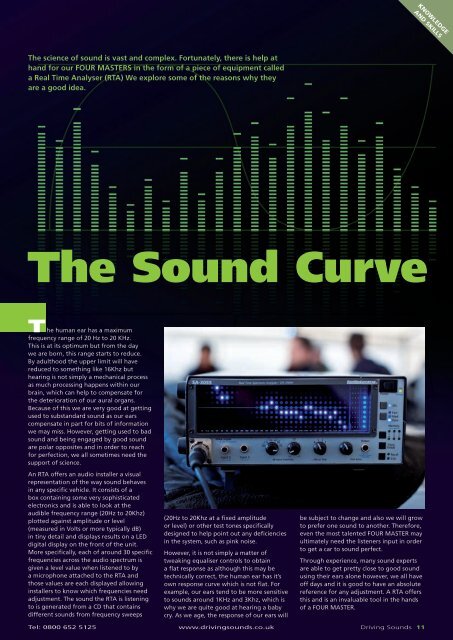For People Who Love Music On The Move - Four Masters
For People Who Love Music On The Move - Four Masters
For People Who Love Music On The Move - Four Masters
You also want an ePaper? Increase the reach of your titles
YUMPU automatically turns print PDFs into web optimized ePapers that Google loves.
<strong>The</strong> science of sound is vast and complex. <strong>For</strong>tunately, there is help at<br />
hand for our FOUR MASTERS in the form of a piece of equipment called<br />
a Real Time Analyser (RTA) We explore some of the reasons why they<br />
are a good idea.<br />
<strong>The</strong> Sound Curve<br />
T<br />
he human ear has a maximum<br />
frequency range of 20 Hz to 20 KHz.<br />
This is at its optimum but from the day<br />
we are born, this range starts to reduce.<br />
By adulthood the upper limit will have<br />
reduced to something like 16Khz but<br />
hearing is not simply a mechanical process<br />
as much processing happens within our<br />
brain, which can help to compensate for<br />
the deterioration of our aural organs.<br />
Because of this we are very good at getting<br />
used to substandard sound as our ears<br />
compensate in part for bits of information<br />
we may miss. However, getting used to bad<br />
sound and being engaged by good sound<br />
are polar opposites and in order to reach<br />
for perfection, we all sometimes need the<br />
support of science.<br />
An RTA offers an audio installer a visual<br />
representation of the way sound behaves<br />
in any specific vehicle. It consists of a<br />
box containing some very sophisticated<br />
electronics and is able to look at the<br />
audible frequency range (20Hz to 20Khz)<br />
plotted against amplitude or level<br />
(measured in Volts or more typically dB)<br />
in tiny detail and displays results on a LED<br />
digital display on the front of the unit.<br />
More specifically, each of around 30 specific<br />
frequencies across the audio spectrum is<br />
given a level value when listened to by<br />
a microphone attached to the RTA and<br />
those values are each displayed allowing<br />
installers to know which frequencies need<br />
adjustment. <strong>The</strong> sound the RTA is listening<br />
to is generated from a CD that contains<br />
different sounds from frequency sweeps<br />
(20Hz to 20Khz at a fixed amplitude<br />
or level) or other test tones specifically<br />
designed to help point out any deficiencies<br />
in the system, such as pink noise.<br />
However, it is not simply a matter of<br />
tweaking equaliser controls to obtain<br />
a flat response as although this may be<br />
technically correct, the human ear has it’s<br />
own response curve which is not flat. <strong>For</strong><br />
example, our ears tend to be more sensitive<br />
to sounds around 1KHz and 3Khz, which is<br />
why we are quite good at hearing a baby<br />
cry. As we age, the response of our ears will<br />
Tel: 0800 652 5125 www.drivingsounds.co.uk<br />
be subject to change and also we will grow<br />
to prefer one sound to another. <strong>The</strong>refore,<br />
even the most talented FOUR MASTER may<br />
ultimately need the listeners input in order<br />
to get a car to sound perfect.<br />
Through experience, many sound experts<br />
are able to get pretty close to good sound<br />
using their ears alone however, we all have<br />
off days and it is good to have an absolute<br />
reference for any adjustment. A RTA offers<br />
this and is an invaluable tool in the hands<br />
of a FOUR MASTER.<br />
Driving Sounds 11<br />
KNOWLEDGE<br />
AND SKILLS


